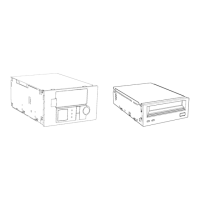glossary 53
Glossary
AT&T mode Berkeley and AT&T functional modes differ in “read-only” close functionality.
In AT&T mode, a device close operation will cause the tape to be
repositioned just after next filemark on the tape (the start of the next file).
autoloader A device embodying a DDS-format tape drive and a cartridge changer
mechanism, together with a magazine holding six cartridges, all housed in a
single case.
Berkeley mode Berkeley and AT&T functional modes differ in “read-only” close functionality.
In Berkeley mode the tape position will remain unchanged by a device close
operation.
block A logical unit of information. Called “record” in the DDS-format specification.
BOT Beginning Of Tape. The first point on the tape that can be accessed by the
drive.
buffered mode A mode of data transfer in write operations that facilitates tape streaming.
compression A procedure in which data is transformed by the removal of redundant
information in order to reduce the number of bits required to represent the
data. This is done by representing strings of bytes with codewords.
DAT Digital Audio Tape
data transfer phase On a SCSI bus, devices put in requests to be able to transfer information.
Once a device is granted its request, it and the target to which it wants to
send information can transfer the data using one of three protocols (assuming
both devices support them): asynchronous, synchronous, and wide.
In asynchronous transfers, the target controls the flow of data. The initiator
can only send data when the target has acknowledged receipt of the previous
packet. All SCSI devices must support asynchronous transfer.
In synchronous data transfer, the initiator and target work in synchronization,
allowing transmission of a packet of data to start before acknowledgment of
the previous transmission.
glossary

